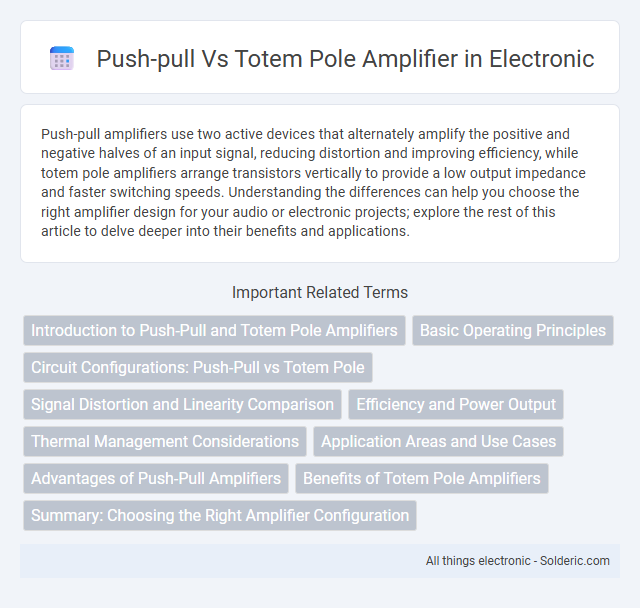Push-pull amplifiers use two active devices that alternately amplify the positive and negative halves of an input signal, reducing distortion and improving efficiency, while totem pole amplifiers arrange transistors vertically to provide a low output impedance and faster switching speeds. Understanding the differences can help you choose the right amplifier design for your audio or electronic projects; explore the rest of this article to delve deeper into their benefits and applications.
Comparison Table
| Feature | Push-Pull Amplifier | Totem Pole Amplifier |
|---|---|---|
| Configuration | Two complementary transistors operating in opposite phases | Two transistors stacked vertically; one sourcing current, one sinking current |
| Application | Audio amplification, Class B, AB amplifiers | Digital logic circuits, output stages in TTL and CMOS devices |
| Efficiency | High efficiency, reduces distortion | Moderate efficiency, optimized for switching |
| Linear Performance | Better linearity with reduced even-order harmonics | Primarily switching, minimal linearity focus |
| Distortion | Low crossover distortion in Class AB | Not designed for analog amplification, distortion not considered |
| Output Stage Role | Delivers power to load with balanced push and pull action | Acts as a push-pull switch to drive outputs high or low |
| Complexity | Moderate complexity; requires biasing to reduce crossover distortion | Simple biasing; mainly used in digital ICs |
| Example Devices | Audio amplifiers, operational amplifier output stages | TTL logic gates, CMOS output stages |
Introduction to Push-Pull and Totem Pole Amplifiers
Push-pull amplifiers utilize two active devices that alternately conduct to amplify both halves of an input signal, effectively reducing even-order harmonic distortion and improving efficiency. Totem pole amplifiers feature a stacked transistor configuration, typically with one device sourcing current and another sinking current, enabling rapid switching and low output impedance. Both topologies serve crucial roles in audio amplification and digital circuits, balancing linearity and switching speed for optimized performance.
Basic Operating Principles
Push-pull amplifiers operate by using two transistors to amplify both halves of the input signal, improving efficiency and reducing distortion through phase cancellation. Totem pole amplifiers arrange transistors stacked vertically to provide a low output impedance and fast switching, ideal for digital and high-frequency applications. Your choice depends on whether you prioritize linearity and power efficiency or speed and output drive capability.
Circuit Configurations: Push-Pull vs Totem Pole
Push-pull amplifiers use two active devices that alternately amplify opposite halves of the signal waveform, providing improved efficiency and reduced distortion in circuit configurations. Totem pole amplifier circuits stack transistors vertically to achieve better voltage gain and faster switching speeds, commonly used in digital output stages. Your choice between push-pull and totem pole amplifiers depends on the desired application, efficiency, and linearity requirements in the circuit design.
Signal Distortion and Linearity Comparison
Push-pull amplifiers exhibit reduced even-order harmonic distortion due to their complementary transistor operation, enhancing overall linearity compared to single-ended designs. Totem pole amplifiers, commonly used in digital circuits, switch transistors alternately to improve efficiency but may introduce higher crossover distortion affecting signal fidelity. Linearity in push-pull configurations typically outperforms totem pole arrangements, making them preferable in high-fidelity analog amplification applications.
Efficiency and Power Output
Push-pull amplifiers offer higher efficiency and better power output by canceling even-order harmonics and allowing for more symmetrical signal amplification. Totem pole amplifiers typically have faster switching times and are used in digital circuits but generally have lower power output and efficiency in analog audio applications. Understanding these differences helps you choose the right amplifier topology for maximizing performance in your specific application.
Thermal Management Considerations
Push-pull amplifiers distribute heat more evenly across output devices, improving thermal dissipation and reducing hotspot formation. Totem pole amplifiers, with stacked transistor configurations, require careful heat sinking to prevent thermal runaway and ensure device longevity. Proper thermal management in your amplifier design is crucial to maintain performance stability and avoid thermal-induced distortion.
Application Areas and Use Cases
Push-pull amplifiers excel in audio amplification and RF applications due to their ability to reduce distortion and improve efficiency, making them ideal for high-power sound systems and radio transmitters. Totem pole amplifiers are commonly used in digital circuits and switching applications because of their fast switching speed and low output impedance, perfect for driving logic gates and microcontroller outputs. Understanding your specific application area will help determine whether the linear amplification of push-pull or the fast switching of totem pole is best suited for your needs.
Advantages of Push-Pull Amplifiers
Push-pull amplifiers offer superior efficiency and reduced even-order harmonic distortion compared to totem pole amplifiers, enhancing audio fidelity and power output. Their symmetrical design helps cancel out noise and distortion components, resulting in clearer signal amplification. You benefit from improved linearity and lower power loss, making push-pull amplifiers ideal for high-performance audio and RF applications.
Benefits of Totem Pole Amplifiers
Totem pole amplifiers offer improved efficiency and faster switching speeds compared to traditional push-pull designs, making them ideal for high-frequency applications. Their compact structure minimizes signal distortion and crossover distortion, enhancing audio fidelity and overall performance in RF circuits. The ability to drive both sourcing and sinking currents simultaneously results in better linearity and reduced power loss, which is critical for modern amplifier designs.
Summary: Choosing the Right Amplifier Configuration
Push-pull amplifiers offer balanced output with reduced even-order harmonics, making them ideal for high-power audio applications requiring efficiency and linearity. Totem pole amplifiers provide a compact, fast-switching solution often used in digital circuits and low-voltage designs, emphasizing low distortion and high gain. Choosing the right amplifier configuration depends on your specific power, distortion tolerance, and application needs to optimize performance.
Push-pull vs Totem pole amplifier Infographic

 solderic.com
solderic.com